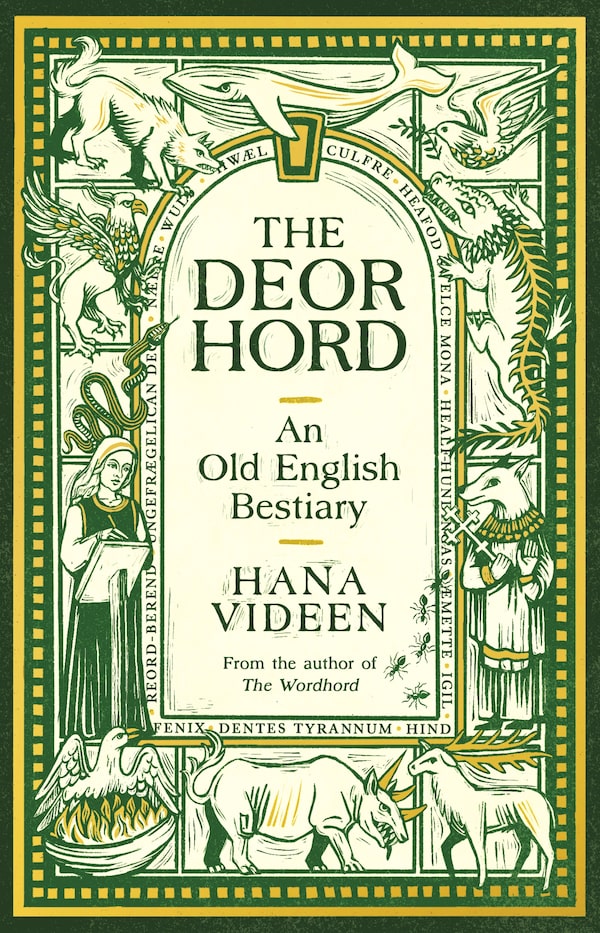
Hana Videen, author of The Deorhord: An Old English Bestiary.Ryan Lintott/Handout
Most medievalists lurk, by necessity, in the shadowed cloisters of academe. Not so for Missouri-born, Toronto-based Hana Videen, who has managed to parlay a PhD in Old English from King’s College, London, into a career writing and blogging about scholarly topics for a non-scholarly audience. In 2021, Videen published a compendium of Old English terms, The Wordhord: Daily Life in Old English, that found an enthusiastic readership (Neil Gaiman called it “delightful”). The Deorhord, her follow-up, takes a similar approach, but with a narrower focus. To lively effect, Videen has created a bestiary, a book of Old English animal lore and etymology where fantastical beasts such as the horse-headed, three-horned teeth tyrant – which Alexander the Great (but no one else) claimed to have seen in India – sit as bedfellows with the equally poetically named, but entirely ordinary walker-weaver (a.k.a. spider). Videen spoke to The Globe from her home via Zoom.

Handout
Tell me about bestiaries, and why you decided to write one.
I’ve always been interested in animals, and when I first discovered bestiaries – which were popular in the 12th and 13th centuries but were based on texts that are a lot older – I was really interested in them, partly because they have these really strange stories, but also because the depictions of them in the illuminated manuscripts are really entertaining. But I’m an Old English specialist, and it didn’t take me long to discover there aren’t any Old English bestiaries. My book was my attempt to create a bestiary of sorts about these animals and to think about which were most relevant to life at the time.
Book recommendations: Globe readers and staffers share their picks
You note that few texts have endured from the Old English period, roughly the equivalent of 30 novels. That doesn’t sound like a lot to work with. Have you read them all?
People are often surprised that I came up with so much material from what doesn’t sound like very many books. I’m familiar with a lot of them, but I haven’t intensely studied them all. I’ve read a lot of poetry, mainly because it came into my PhD dissertation, and was my interest.
There are also leechbooks, such as medical texts, that I’ve read around in, but haven’t read cover to cover. Same with saints’ lives and sermons and things like that. With a lot I looked at a specific story or saint or homily, but haven’t necessarily gone through and read them all in Old English.
So how did you choose the animals that appear in The Deorhord?
Several years ago, while doing my PhD, I teamed up with an artist. I would translate a passage of Old English describing an animal, then I would give him the description and he would attempt to draw my description without having a background in the Middle Ages. We have that as a website now, medievalandmodernbestiary.com. He’s first in my acknowledgments because he did an amazing job creating the visuals for these stories.
So I’d already thought about certain animals from that project. And there’s a Middle English Physiologus, which is a bit later than my period of study, but talks about a lot about the animals that are in bestiaries, so I used that as a guide as well. I’d say, for instance, okay, the lion is an important figure in bestiaries – do lions show up in Old English at all?
There are many familiar animals here – lions, deer, wolves – but cats and dogs are noticeably absent.
They don’t turn up very much in Old English, especially cats. You get big cats like the panther lion, but you don’t get house cats much, except in glossaries, which were basically the dictionaries of the time.
For the chapter on extraordinary animals, which I called “Animals Unheard Of,” I collected a bunch of animals I thought were interesting, but they’re very short descriptions; there’s not a whole lot we can say about them. It’s also interesting to see which animals played a big role in the literature, like whales, wolves and eagles.
The whales were a surprise, specifically that they fall into the “Bad Animal” category, when today they’re synonymous with virtue.
The metaphor that basically got stuck on them was this idea of the devil pulling people down to their doom. I talk in the book about how the panther and the whale have very similar qualities in the way they attract other animals. They have this charisma. In the pagan texts from Pliny and much earlier, they’re treated more as the baddies. When these texts were Christianized, the panther, for whatever reason, got turned into a good guy but the whale stayed bad.
Any other animals to which our attitudes have notably changed since medieval times?
I was surprised that the snake could potentially not be a baddie. I tried to categorize the animals when I wrote this book, but they don’t always fit the categories. So sometimes you get a snake representing the ability to shed previous sins through confession, to become a better person, whereas we usually think of the snake as being representative of the devil.
Ants are really weird in the stories. They’re a model of good behaviour because of the way they work together, but then you have these monstrous ones in the stories of Alexander the Great that are still called ants, but they’re guarding their gold in a way that you might think is greedy. They kill people, and camels.
What do these ancient texts and stories tell us about the people who wrote them?
They highlight concerns about religion and how people thought about sin and salvation; about which animals loomed large as something threatening or something gentle. An elephant is described as being quite a gentle creature, for example, even though they’re the size of mountains.
They tell you a bit about the texts they were influenced by, some of which were popular in different parts of Europe. Some of the characters and stories are also found in the Middle East or Scandinavia, for example, which shows how connected the ideas were from this time – people tend to think that people in medieval England didn’t travel, but that’s actually not the case.
The creatures you categorize as “baffling” are pretty show-stopping. Do you have a favourite?
One has got to be the nicor, this water-monster, which turns up in quite a few places but is never really described. You feel like whoever’s telling about this creature is assuming that everyone knows what it looks like. You don’t get the sort of details – number of horns, the kind of spines on their back – that you get for the moon-head or the teeth tyrant. You just get the sense that these creatures are scary and dangerous and live in the water, and that’s about it.
I think it’s really interesting that you have this assumed creature that maybe was part of the popular imagination of the time but isn’t part of ours. It doesn’t endure through the Middle English period. There’s no continuity with later writings. I love those creatures just because they’re so puzzling.